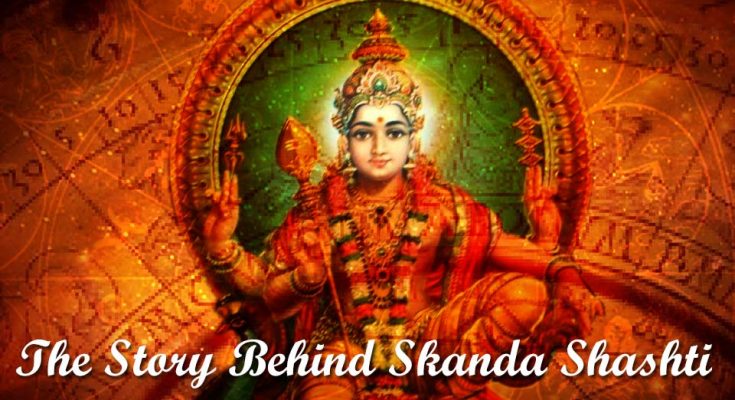Skanda Sashti, also known as Kanda Shashti is a holy day for the Hindus dedicated to the Lord Kartikeyan. As per the Hindu beliefs, Lord Karthikeyan is the son of Lord Siva and Goddess Parvathy. Skanda, Subramanya, Murugan etc. are other common names of the lord and is one of the most worshipped Hindu deities in South India, especially in Tamil Nadu. Lord Kartikeyan or Murugan is regarded as the God of war and knowledge.
Skanda Sashti befalls on the sixth day of the waxing phase (sixth thithi of Shukla paksha) of every lunar cycle. Skanda refers to Lord Kartikeya and shashti refers to the sixth thithi or lunar day. Though Skanda Sashti befalls on every month, that occurring in the Tamil lunar month of Kartika (or solar month Aippasi) is the most significant and widely celebrated one. The month Kartika corresponds to the October-November period in the Gregorian calendar. The Skanda Sashti celebrations are meant to commemorate the incarnation of Lord Karthikeyan and his victory over the demon Surapadman. Grand celebrations occur in the Murugan Temples in Tamil Nadu and devotees observe fasting (Skanda Sashti Vrutam) and other penances on this sacred occasion.
Legend of Karthikeyan/Murugan
The Hindus in South India consider Lord Karthikeyan as the younger sibling of Lord Ganesha while those in North India consider him as the elder sibling of Ganesha. There is a legend behind the birth of Lord Kartikeyan and his killing of Surapadma.
Once, the three demons Surapadman, Simhamukhan and Tarakasuran created havoc to the entire world. Surapadman had a boon from Lord Siva that he would be killed only by Siva’s own powers. This made him so powerful that he and his brothers became a threat to the humans and devas. As the devas wanted to get rid of these demons, they decided to approach Lord Siva who is the sole power capable of vanquishing the demons. But, it became an uneasy task for them as Siva was engaged in a severe meditation. So, the devas sent the God of Love Manmata to arouse amorous desires in Siva and to disengage him from the meditation.
When Manmata shot his Pushpasaram (arrow of flowers) on Lord Siva, his meditation was disturbed. This infuriated the lord and he burned Manmata to ashes. Later, upon the supplication of all the devas, Siva resurrected Manmata and decided to give birth to a child inheriting all his powers for vanquishing the demons.
Lord Shiva gave out six sparks from his third eye which were carried by the God of fire Agni to the cooling waters of river Saravana where the six sparks were manifested into six divine babies. Six damsels named Kartika sisters (symbolic to the six stars of the constellation Kartika or Pleiades) agreed to nurture these babies. Once, when Mother Parvati visited the six children growing in the pond and embraced them all at once, they merged to form one child with six faces, twelve hands and two feet. This majestic figure was named Kartikeyan. Mother Parvati gifted him the skills, prowess and a lance which is called Vel in Tamil.
Karthikeyan grew up into a philosopher and warrior. He became an embodiment of wisdom and compassion and he also had immense knowledge in warfare. He, along with his assistants waged a war against the deadly demon Surapadman and his brothers. On his way to the city of the demon, the Lord killed Surapadman’s brothers Simhamukhan and Tarakasuran. Then, there was a fierce battle between the lord and demon in which he severed Surapadman with his Vel. A peacock and a cock emerged from Surapadman’s body of which the earlier one became the lord’s vahana (carrier or vehicle) and the later one got emblazoned on his flag as a symbol of victory over evil.
Sashti is the day in which Karthikeya defeated Surapadma. It is also said that when Surapadman got mortally wounded, he asked the Lord to spare him and thus Muruga turned him to a peacock on the provision that he would forever be his vahana.
Shashti Celebration
The festival of Skanda Shashti is celebrated enthusiastically in Tamil Nadu and other states. In most of the Murugan Temples, it is a ten days long event which culminates with the enacting of the killing of demon termed as Soorasamharam. In the temple for Lord Subramanya located in Tiruchendur (the place where the final battle between Murugan and Surapadman took place), the festival is celebrated with great vigour. Devotees throng from all places to visit the Tiruchendur temple and to witness the grand event of enacting the killing of the demon.
Large fairs are conducted every year on Skanda Sashti in the famous Murugan temples in South India – Thiruparamkunram, Tiruchendur, Palani, Udupi etc. and those in Malaysia and Sri Lanka. Special mention must be given to the grand celebrations in Thirupparamkunram and Tiruchendur temples which are two of the Arupadai Veedu temples of Murugan. The exploits of the lord and the events leading to the conquest of the demons are dramatized and enacted here. In the Sikkal Singaravelan temple, the Subramanya idol receives a Vel (symbolic to Mother Parvati’s gifting of Vel) from the Ambal shrine and breaks out in sweat a day before the climax of the festival.
Devotees undertake fast, visit temples, sing devotional songs and recite hymns and prayers of Lord Subramanya. Hymns from Kavadichindu, Skanda Shashti Kavacham and Tiruppugal are sung on this occasion. The offering of Kavadi on Skanda Sashti is a popular worship. It is a customary penance in which the devotees would pierce long needles through their cheeks, lips and tongue while carrying the Kavadi. While doing so, they get into a delirium charmed by the power of Muruga.








